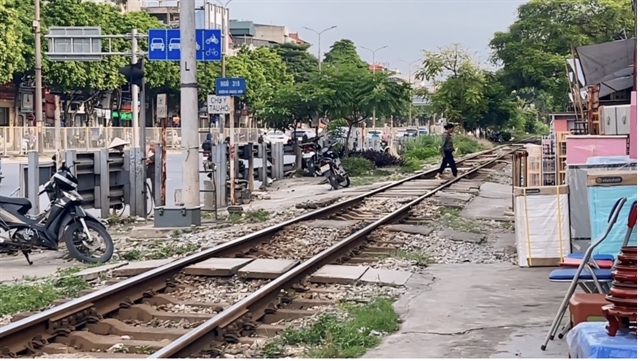 Society
Society

 |
| Residents casually cross the railway to shop at the makeshift market next to the tracks. Photo kinthtedothi.vn |
HÀ NỘI - Despite the efforts of the authorities, the violation of railway safety corridors continues to occur daily in Hà Nội, especially in densely populated areas.
According to the Ministry of Transport, from 2019 to 2023, there were still over 3,000 unauthorised railway crossings nation-wide, primarily in urban areas with high train traffic.
Despite work to stop dangerous rail track crossings and close-to-the-track builds, over the past five years, only 777 out of 4,093 (less than 20 per cent) prohibited crossings in densely populated areas have been eliminated.
Common violations include the construction of shacks, businesses operating near railway tracks, illegal crossings and ignoring warning signs. These activities are widespread, posing significant risks of accidents.
 |
| Residents crossing railway areas without barriers face significant risks. Photo kinhtedothi.vn |
Notably, in Hà Nội, along the railway routes through Bắc Từ Liêm, Thanh Trì, and Thường Tín districts, violations of railway safety corridors are prevalent.
For example, at alley No. 119 in Cổ Nhuế Street of Bắc Từ Liêm District, an unofficial market has long been established parallel to the railway.
Residents casually cross the rails to shop at the market adjacent to the tracks and this market causes traffic congestion and poses serious risks to railway safety.
The railway corridor is also used for drying clothes, despite prohibitory signs, creating an untidy and hazardous environment.
Đỗ Phương Thảo, a resident in the area, told kinhtedothi.vn: “The market here poses a risk of accidents. If a train comes and people don't move in time, the consequences could be dire.”
In the same area, the railway section passing through Alley No. 104 in Cổ Nhuế Street lacks barriers separating the road from the railway, leading residents to cross the tracks recklessly.
Lieutenant Dương Thanh Khánh, a traffic policeman, said: “The ward police frequently address these violations, preventing stalls within the railway safety corridor.
“We have proposed that the district authorities and Hà Thái Railway Company erect protective fences along the corridor.
"Meanwhile, we strive to maintain order and safety, but it is challenging to monitor constantly.”
 |
| Along Ngọc Hồi Street, seld-made paths across the rail line appear continuously and business is conducted right next to the tracks. Photo kinhtedothi.vn |
Unauthorised crossings cutting through railway tracks are a primary cause of many traffic accidents.
Along Ngọc Hồi Street, from section at Tứ Kỳ Pagoda in Hoàng Liệt Ward, Hoàng Mai District to Văn Điển Town, Thanh Trì District, numerous unauthorised crossings are seen every few metres.
These crossings lack proper barriers and warning signs and residents cross the tracks carelessly. Shops are opened close to the railway tracks.
Nguyễn Thị Trí, a resident living in Văn Điển Town said: “Residents are quite negligent when crossing the tracks. Only one or two crossings should be open for residents, as many unauthorised ones are dangerous.
“Even as a train approaches people, including the elderly and children, still calmly cross the train line. It is very common and is a terrifying sight.”
Most of these crossings are created illegally by residents with makeshift concrete slabs. Over time, these shortcuts become permanent paths, convenient but risky.
Nguyễn Thị Hương, chairwoman of the People's Committee of Văn Điển Town, said: “We have reviewed and installed warning signs to alert residents when crossing the tracks. At certain accident-prone spots, the town mobilises groups to monitor during peak hours. However, manpower is still limited.”
The local authorities have closed nine out of fifty-nine unauthorised crossings without affecting the adjacent households' traffic.
Hương emphasised that to resolve railway accidents definitively, all unauthorised crossings must be closed.
For this to happen, a project to construct parallel roads for residents must be initiated. The local authorities are reviewing land along the railway safety corridor to propose this project to the higher authorities.
Violations of railway safety corridors primarily stem from a lack of awareness among some residents who fail to recognise the severe consequences of their actions, said the chairwoman.
Moreover, local authorities need to tighten management, collaborate with the railway sector and enforce the removal of violations to prevent re-encroachment.
At particularly troublesome spots, constructing parallel roads for residents is essential to ensure safe and convenient travel, she added. VNS




